Opal: Properties, Uses and Virtues
Opals, with their incredible play of colours, occupy a special place among gems, captivating hearts with their unique charm.
As we delve into the world of opals, we’ll uncover their captivating geological formation, trace their historical importance through the ages, and discover the metaphysical properties that add to their appeal.
Join us on this journey to explore the diversity of opal varieties and colours, understand their durability and enhancements, and learn how to cherish and preserve these gems for eternity.

Opal: Table of contents
- Opal Geological Formation
- Rough Opal – Raw Beauty
- Sources – World Range of Opal
- Historical Significance of Opal – Through the Ages
- Metaphysical properties of Opal – Illuminating energies
- Opal varieties
- Opal colors
- Durability and Wearability of Opal
- Opal Enhancements – Preserving Natural Beauty
- Synthetic Opal – Nature in the Laboratory
- Imitations of Opal – Discerning the Authentic
- Opal Care – Preserving natural beauty
- The Buying Guide – Everything you need to know!
Opal Geological Formation
Opals, iridescent wonders of nature, are formed through a captivating process. These gems are formed when silica-rich liquids seep into voids or cracks in rocks, gradually solidifying over millions of years.
The complex interplay of light and silica spheres in the opal structure gives rise to the fascinating interplay of colours that makes these gems so unique among precious stones.
Rough Opal – Raw Beauty
In their raw state, opal crystals reveal a raw natural beauty that captures the imagination of gem enthusiasts. As opal is not a crystalline material, it does not have a crystalline form as such.
These uncut gems come in a variety of shapes and sizes, each revealing an astonishing palette of colours and patterns. From the fiery reds of fire opal to the mysterious dark shades of black opal, uncut opal crystals offer a glimpse of nature’s artistry.
Sources – World Range of Opal
Opals are found in different parts of the world, with each region contributing to their unique characteristics. Australia, known for its Australian opals, particularly black opals, is the main source of these precious gems.
Ethiopia is renowned for its exquisite Ethiopian opals, while Mexico and the United States are also notable opal-producing regions.
Historical Significance of Opal – Through the Ages
The historical importance of opals dates back thousands of years, with these gems captivating the hearts and cultures of various civilisations. Throughout history, opals have been revered, celebrated and adorned for their captivating play of colour and mystical aura.
Here are some key aspects of the historical importance of opals:
Ancient beliefs and superstitions
Opals have been associated with many myths, legends and superstitions. In ancient times, opals were believed to be tears shed by the gods and were held in high esteem, associated with divine protection and foresight.
Roman Adoration
The ancient Romans admired opals as a symbol of love and hope. They believed that opals were the most precious and powerful gems of all because of their ability to capture a spectrum of colours. Opals were highly prized and worn as jewellery by the Roman nobility and upper classes.
Middle Ages and Renaissance
During the Middle Ages, opals were prized for their supposed protective qualities. They were believed to have the power to ward off evil and preserve the eyesight of their wearers. Opals were popular with monarchs and nobility, and were frequently used in crowns, sceptres and other royal jewels.
Opals as Symbols of Luck and Love
Opals were often exchanged as gifts to bring good fortune and happiness to the recipient. They were thought to strengthen romantic love and relationships, making them popular gifts for lovers and couples.
Opals in Victorian Mourning Jewellery
In the Victorian era, opals had a unique place in mourning jewellery. They were thought to protect and comfort the bereaved, symbolising hope and eternal life. Queen Victoria, herself a fervent admirer of opals, popularised their use as symbols of mourning and remembrance.
The Rise and Fall of Opal
Despite their popularity, opals have gone through periods of disaffection fuelled by superstition. In the 19th century, a fictional novel entitled “Anne of Geierstein” by Sir Walter Scott portrayed opals as an ominous symbol, leading to a temporary drop in demand. This phenomenon has become known as the “opal bad luck myth”.
The superstition that opals are unlucky can also be linked to historical events, such as the Black Death, when a patient’s opal lost its brilliant set of colours on death, creating a sinister association with misfortune. Moreover, in the 19th century, rumours spread by diamond merchants seeking to discredit the competition from opals fuelled the negative perception, perpetuating the belief that opals were bad luck.
However, the reputation of opals gradually recovered as jewellers and gem enthusiasts continued to showcase their unique beauty.
Renaissance Moderne des Opales
In recent times, opals have enjoyed a resurgence in popularity, becoming the birthstone of October and being celebrated for their exceptional beauty and individuality.
As more and more people have come to appreciate their enchanting play of colours and striking appearance, opals have become highly prized as striking gems in contemporary jewellery designs.
Metaphysical properties of Opal – Illuminating energies
Opals are thought to possess metaphysical properties that promote emotional healing and spiritual transformation. Often associated with love, passion and creativity, opals are believed to encourage self-expression and inspire a sense of hope and positivity.
As a stone of transformation, opals are believed to facilitate personal growth and spiritual awareness.
Opal varieties
Opals, gemstones celebrated for their bewitching play of colour, come in a fascinating range of varieties, each with its own unique characteristics and appeal. Let’s dive into the diverse spectrum of opal and explore the following captivating varieties:
White or Clear Opal
White or clear opals are renowned for their delicate background colour, allowing the bewitching interplay of colours to shine through with ethereal beauty. Their translucent to semi-transparent appearance enhances the spectral dance of colours, creating an enchanting spectacle ranging from soft pastels to vivid hues. Often set against a light background to enhance the play of colours, these opals exude an elegant, luminous charm.
Grey or Dark Opal
Grey or dark opals have a fascinating background colour ranging from dark grey to almost black. Their play of colours unfolds with striking contrast against the dark background, creating a dramatic and intense visual display. These opals exude an aura of mystery and sophistication, making them an ideal choice for those seeking opals with strong appeal and a seductive presence.
Black Opal
Among the most revered and sought-after opals, black opals present a bewitching play of colours against a dark or black background. Their extraordinary brilliance and intensity make them some of the most sought-after gemstones in the world. The contrast of the play of colours against the black background creates a captivating spectacle reminiscent of galaxies and fireworks, leaving admirers in awe.
Boulder Opal
Boulder opals are unique and cherished for their captivating play of colours displayed on the natural sandstone matrix. These opals often feature an intriguing pattern where the gem material fuses with the host rock, creating a striking contrast between the colour of the opal and the earthy matrix. Boulder opals have a rustic charm and natural appeal that distinguish them as remarkable treasures of nature.
Crystal Opal or Water Opal
Crystal opals are renowned for their transparent to semi-transparent appearance, allowing the interplay of colours to shine with exceptional brilliance. These opals display a captivating play of light and colour, creating a spellbinding spectacle. Their transparency increases their versatility, as they can be cut into a variety of shapes, making them an ideal choice for creating fine, elaborate jewellery.
Fire Opal
Fire opals are celebrated for their fiery, intense base colours, ranging from warm yellows and oranges to deep reds. Unlike opals with a play of colours, fire opals captivate with their vibrant hue alone, often appearing as if they contain a fiery flame within. These opals emanate a passionate and bold aura, making them a popular choice for statement pieces and eye-catching jewellery. These revered opals are also known as Mexican opals.
Opal Fossil
Fossil opals are a unique and captivating form of opal that forms inside fossil remains such as bones, shells or wood. Over time, silica-rich water replaced the organic matter, leaving behind opal in the fossil’s complex structure.
Fossil opals present an enchanting fusion of the past and the gem’s mesmerising play of colour, creating a treasure that encapsulates millions of years of history and natural art.
Common Opal
Common opal includes all opals that do not show any play of colour.
Opal colors
The bewitching colours of opals have captivated hearts for centuries. From intense reds and oranges to serene blues, greens and pinks, opals display a kaleidoscope of hues. The interplay of colours, known as opalescence, lends a dynamic, magical quality to these gems, making each opal a unique and cherished treasure.
Durability and Wearability of Opal
Opals, while enchanting, have a moderate level of hardness (around 5.5 to 6.5 on the Mohs scale) and require delicate care. Their delicate nature makes them vulnerable to scratches and damage. Opal jewellery must be handled with care and protected from extreme temperature changes and harsh chemicals to preserve its fragile beauty.
Opal Enhancements – Preserving Natural Beauty
Opals, with their bewitching play of colours and unique beauty, are cherished for their natural appeal. While most opals are prized in their pure, untreated state, certain enhancement and treatment techniques are used to improve their appearance, durability or market value.
Let’s explore the common enhancement and treatment techniques associated with opals:
Stabilisation
Opals with a porous or fragile structure can be stabilised to improve their durability and prevent cracking or chipping. This process consists of impregnating the opal with a transparent resin or polymer, thus reinforcing its structure and increasing its resistance to wear and damage.
Stabilisation is often transparent, to preserve the opal’s natural play of colour without significantly altering its appearance.
Smoke Treatment
Smoke treatment is a traditional method used to darken the background colour of light-coloured opals, particularly white opals. The opals are exposed to smoke, which penetrates the gem’s microfissures and enhances its background colour, creating a sharper contrast with the play of colours.
This treatment is reversible and temporary, as it can fade over time or with exposure to various elements.
Sugar Treatment
Sugar treatment is a unique and ancient technique used to enhance the play of colour in opals. The opals are immersed in a sugar solution and then sprinkled with sulphuric acid so that the water is removed and only the dark carbon remains. This process enhances the play of colours by creating a dark base inside the gem.
Similar to smoke treatment, the effects of sugar treatment are not permanent and may diminish over time.
Composite Opal
Composite opals combine natural opal with other materials to improve the appearance and profitability of the gem. These opals are made from a thin slice of precious opal, which is then attached to a support material such as black potch or ironstone.
The backing material provides support for the thin slice of delicate opal, resulting in a stone with a vivid play of colours contrasting with a striking background.
Opal Doublets
Opal doublets are a popular opal composite composed of two layers. The top layer is a thin slice of precious opal, while the bottom layer is usually made of common opal or glass.
The top layer displays the captivating colour scheme, while the bottom layer offers extra stability and protection. Opal doublets offer an affordable option for enjoying the beauty of opal without the full cost of a solid opal.
Opal Triplets
Opal triplets are another form of composite opal, comprising three layers. The top layer is precious opal, followed by a thin slice of transparent material, such as quartz or glass, and a black backing material at the bottom. The transparent layer acts like a protective shield, amplifying the opal’s play of colours and creating a vibrant visual effect.
Opal triplets are an economical choice for opal jewellery because of their layered composition.
Mosaic Opal
Mosaic opals involve assembling small pieces of precious opal to form complex patterns or designs. This technique allows lapidaries to use small opal fragments that would be unsuitable for larger, solid opals.
Mosaic opals offer a harmonious blend of colours and can be cut into different shapes, making them a popular choice for handcrafted jewellery.
Synthetic Opal – Nature in the Laboratory
Opal does not exist strictly in synthetic form, because a synthetic gemstone is made in a laboratory, but it shares all the characteristics of the natural gem. It is not yet possible to recreate the geological formation of real opal.
Every ‘synthetic opal’ on the market is an imitation, although the term ‘synthetic’ is accepted in some circles, notably Gilson opal.
Imitations of Opal – Discerning the Authentic
Because of their popularity and value, opals are often imitated or misrepresented. Buyers should be extremely careful when purchasing an opal. Many unscrupulous sellers and jewellers present opal composites such as doublets and triplets as natural and ignore any dyeing or doubling treatment. Buying opals from reputable and certified gem dealers guarantees authenticity.
Here are some common imitations used on the market:
Gilson Opal
Gilson opal is a well-known synthetic opal that imitates the appearance of natural opals with remarkable precision. Created by Pierre Gilson in the 1970s, this imitation opal is made from silica spheres and a resin binder, with the aim of reproducing the bewitching play of colours in opals. Although Gilson opal has a magnificent play of colours, it does not have the organic properties of natural opals.
Aurora Opal
Aurora opal is another variant of synthetic opal that attempts to reproduce the vibrant colours seen in real opals. This imitation uses a resin-based material to mimic the dazzling spectral display of natural opals. However, attentive gem enthusiasts can distinguish Aurora opals from real ones by observing the differences in their patterns and optical properties.
Sterling Opal
Sterling opal is a composite opal that involves a thin slice of natural opal bonded to a black onyx backing. The black background creates an illusion of depth and contrast, reinforcing the play of colour. Although visually attractive, Sterling opals are not entirely natural and may not have the same properties as solid opals.
Mexifire Opale
The Mexifire® opal created by Rhea Industry is currently the closest imitation to natural fire opal, but has a lower density.
Slocum glass
Slocum glass is a type of imitation silicate glass that resembles the colour play of opals, but does not have the internal structure of the gem or a natural origin. These imitations are often used in costume jewellery because of their affordability.
Transparent and Plastic Labradorite
Labradorite is a natural gemstone renowned for its beautiful iridescence. However, transparent labradorite or plastic imitations similar to labradorite can be used to imitate the colour play of opals. It is important to differentiate these imitations from genuine opals to make informed purchasing decisions.
To protect the authenticity of opals, it is crucial to buy them from reputable gem dealers who provide full information on the gem’s origin, processing history and any improvements made. Natural, untreated opals continue to be cherished for their unrivalled beauty and iridescent charm, presenting themselves as timeless treasures from the depths of the Earth.
Opal Care – Preserving natural beauty
Taking care of opal jewellery is essential to preserving its timeless beauty.
Opals should be cleaned gently with mild soapy water and a soft brush, avoiding exposure to aggressive chemicals.
It’s best to store opal jewellery separately to avoid scratches and damage, ensuring that these superb gems shine brightly for generations to come.
The Buying Guide – Everything you need to know!
Need help buying opal jewellery? Would you like to know all about the pitfalls to avoid, the questions to ask and how to spot imitations? Check out the ultimate buying guide for opal jewellery!
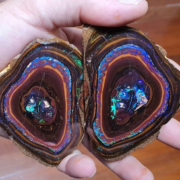
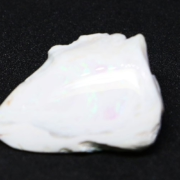
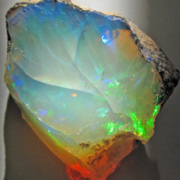
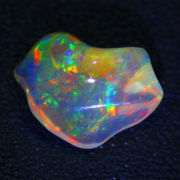
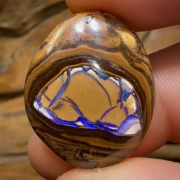
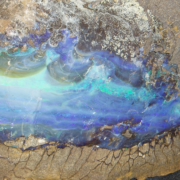


Leave a Reply
Want to join the discussion?Feel free to contribute!